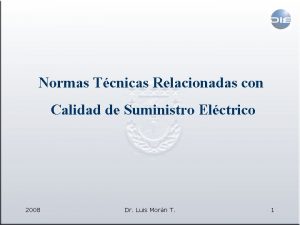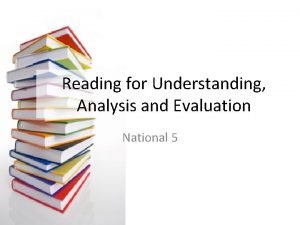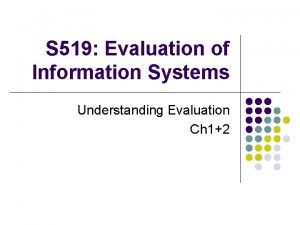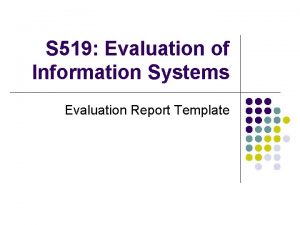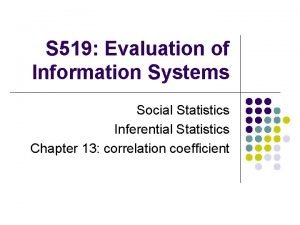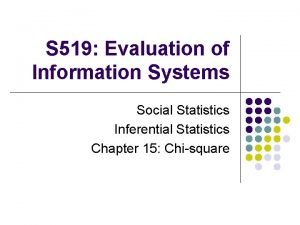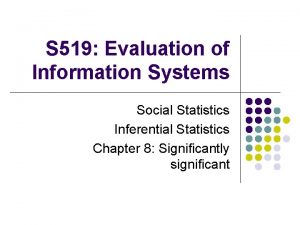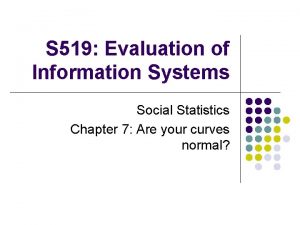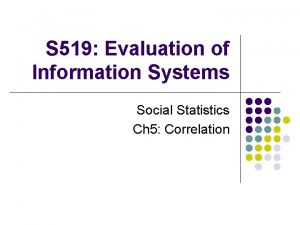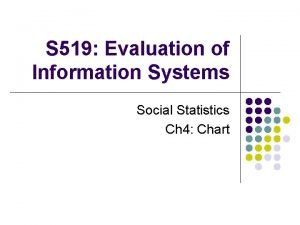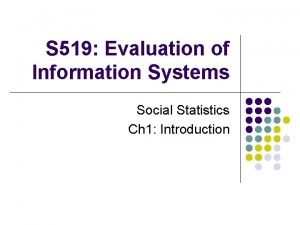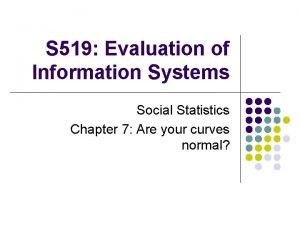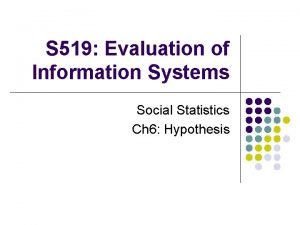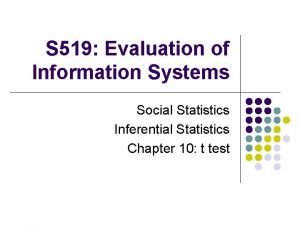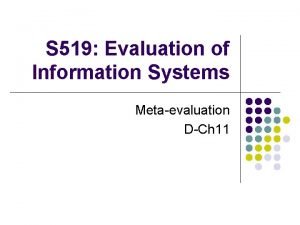S 519 Evaluation of Information Systems Understanding Evaluation

















- Slides: 17

S 519: Evaluation of Information Systems Understanding Evaluation Ch 1+2

Definition of Evaluation l l Systematic determination of the quality or value of something (Scriven, 1991) What can we evaluate? l l l Projects, programs, or organizations Personnel or performance Lessons-learned Policies or strategies and methods are transdisciplinary Products or services Processes or systems Proposals, contract bids, or job application

Terminology (Davison, Glossary) l Evaluand l l That which is being evaluated (e. g. Program, policy, project, product, service, organization) In personnel evaluation the term is evaluee

Issues of Evaluation l Evaluation is for l l l Find areas for improvement Generate an assessment of overall quality Answer the question of „Merit“ or „Worth“ (Scriven, 1991) l l Merit is the „intrinsic“ value of something = „quality“ Worth is the value of something to an individual, an organization, an institution – contextualized merit -- = „value“

Choosing the right group l Accountability evaluation l It is important to conduct an independent evaluation l l i. e. Nobody on the evaluation team should have a significant vested interest in whether the results are good or bad Organization learning capability evaluation l It can (better) be dependent evaluation l i. e. Organizational staff, consultants, managers, customers, trainnees etc. can join.

The steps involved (D-p 4) l l Step 1: understanding the basic about evaluation (ch 1) Step 2: defining the main purposes of the evaluation and the „big picture“ questions that need answers (ch 2) Step 3: Identifying the evaluative criteria (ch 3) Step 4: Organizing the list of criteria and choosing sources of evidence (collecting data) (ch 4)

The steps involved (D-p 4) l Step 5: analyzing data l l l dealing with the causation issue (which cause what, why), to avoid „subjectivity“ (ch 5+6) importance weighting: weight the results (ch 7) Meric determination: how well your evaluand has done on the criteria (good? Unacceptable? ) (ch 8) Synthesis methodology: systematic methods for condensing evaluation findings (ch 9) Staticistical analysis: Salkind (2007)

The steps involved (D-p 4) l Step 6: result l l Putting it all together: fitting the pieces into the KEC framework (ch 10) Step 7: feedback l Meta-evaluation: how to figure out whether your evlauation is any good (ch 11)

The Key Evaluation Checklist (Davidson, 2005, p. 6 -7) I. Executive Summary II. Preface 1. Background 2. Descriptions & Context & Definitions 6. Process Evaluation 7. Outcome Evaluation III. Methodology 3. Consumers 4. Resources 8 & 9. Comparative Cost-Effectiveness 5. Values 10. Exportability 11. Overall Significance 12. 13. Responsibilities Recommendations & Explanations 14. Reporting & Follow-up 15. Meta-evaluation

Step 1: Understand the basic of evaluation l l Identify the evaluand Background and context of evaluand l l Descriptions and definitions l l Why did this program or product come into existence in the first place? Describe the evaluand in enough detail so that virtually anyone can understand what it is and what it does How: collect background information, pay a firsthand visit or literature review

Are you ready for your first evaluation project? l Some tips before you start l l Make sure that your evaluand is not difficult to access (geolocation, inanimate objects) Make your evaluand a clearly defined group (avoid abstract and complex system) Avoid political ramification (assess your boss pet project, university administration) To avoid your invovlement in the evaluand (to assess a class which you are teaching, etc. )

Previous Projects l l l l l Metadata discussion group Brown Bag discussion group Twitter SLIS website Information Visulization Lab website Media and Reserve Services in Wells Library IU CAT So. E website Chemistry library website

Step 1: Output report l Output: one or two page overview of the evaluand findings l l l What is your evaluand Background and context of your evaluand Description of your evaluand l Try to be as detail as possible

Step 2: Defining the Purpose of the Evaluation (D-Ch 2) l l l Who asked for this evaluation and why? What are the main evaluation questions? Who are the main audience?

Evaluation purposes l A. what is (are) the main purpose(s) of the evaluation? l To determine the overall quality or value of something (summative evaluation, absolute merit) § l i. e. Decision making, funding allocation decision, benchmarking products, using a tool, etc. To find areas for improvement (formative evaluation, relative merit) § § To help a new „thing“ to start To improve the existing „thing“

Big picture questions l Big picture questions: l B. What is (are) the big picture question(s) for which we need answers? l Absolute merit § l Do we want to invest this project? relative merit § § How does this project compare with the other options? Ranking

Step 2: Output report l Your step 2 output report should answer the following questions: l Define the evaluation purpose l l Do you need to demonstrate to someone (yourself) the overall quality of something? Or Do you need to find a file for improvement? Or do you do both? Once you answer above questions, figure out what are your big picture questions: l l Is your evaluation related to the absolute merit of your evaluand? Or the relative merit of your evaluand
 Ieee 519-2014
Ieee 519-2014 Upenn cis 419
Upenn cis 419 Cis 419 upenn
Cis 419 upenn Cis 419 upenn
Cis 419 upenn Ieee-519
Ieee-519 Cs 519
Cs 519 Cs 519
Cs 519 Gnp gdp meaning
Gnp gdp meaning L1111l
L1111l Cis 419 upenn
Cis 419 upenn Reading for understanding analysis and evaluation
Reading for understanding analysis and evaluation Understanding experience in interactive systems
Understanding experience in interactive systems Operating system history
Operating system history Transalate
Transalate Decision support systems and intelligent systems
Decision support systems and intelligent systems Principles of complex systems for systems engineering
Principles of complex systems for systems engineering Embedded systems vs cyber physical systems
Embedded systems vs cyber physical systems Elegant systems
Elegant systems




